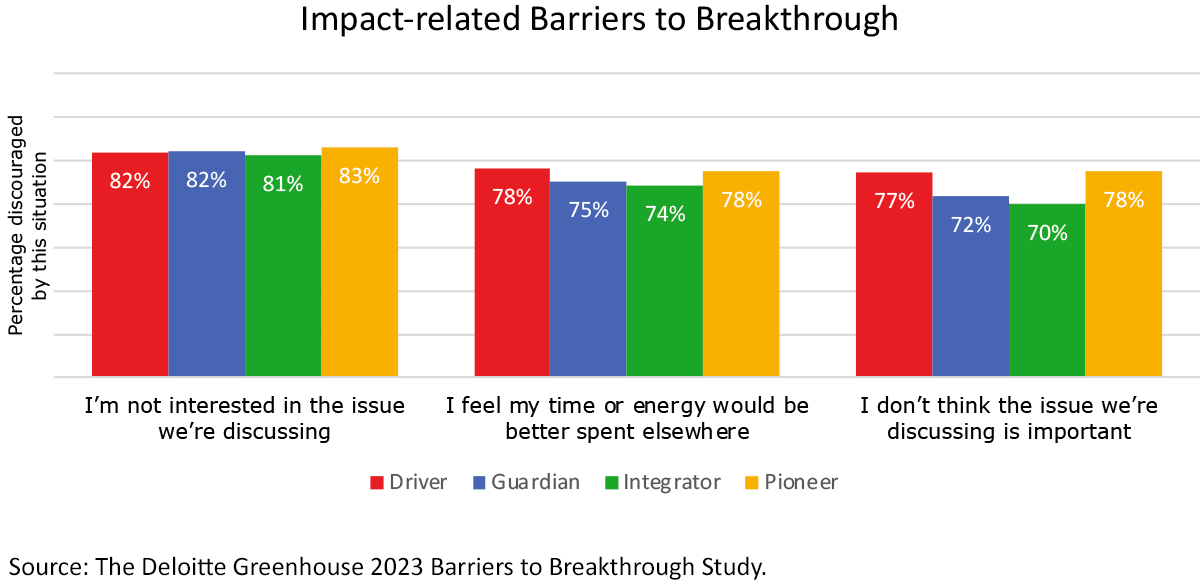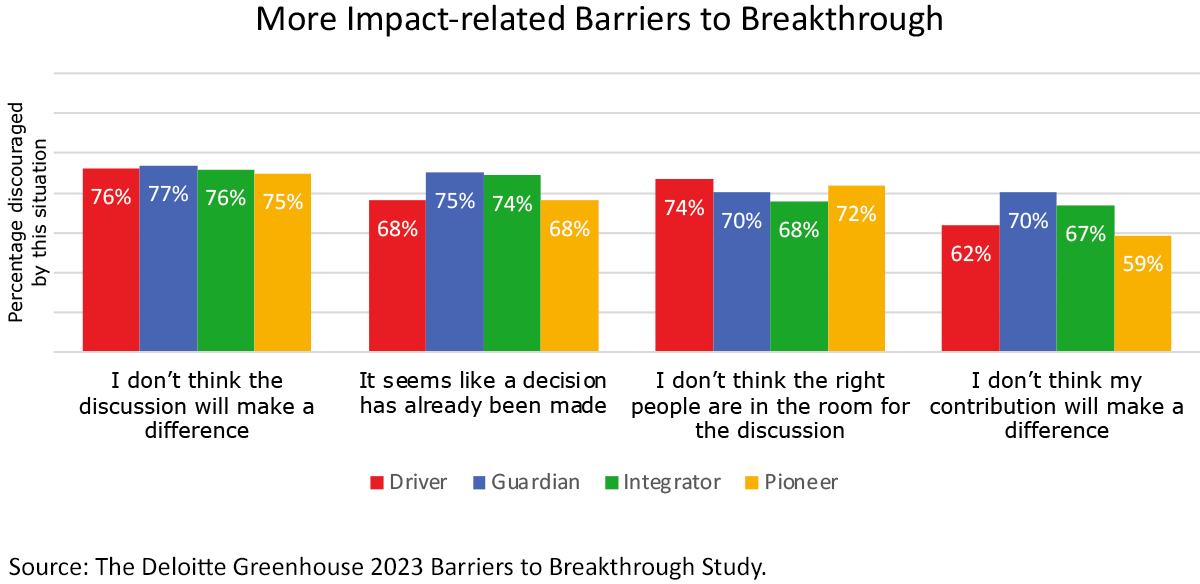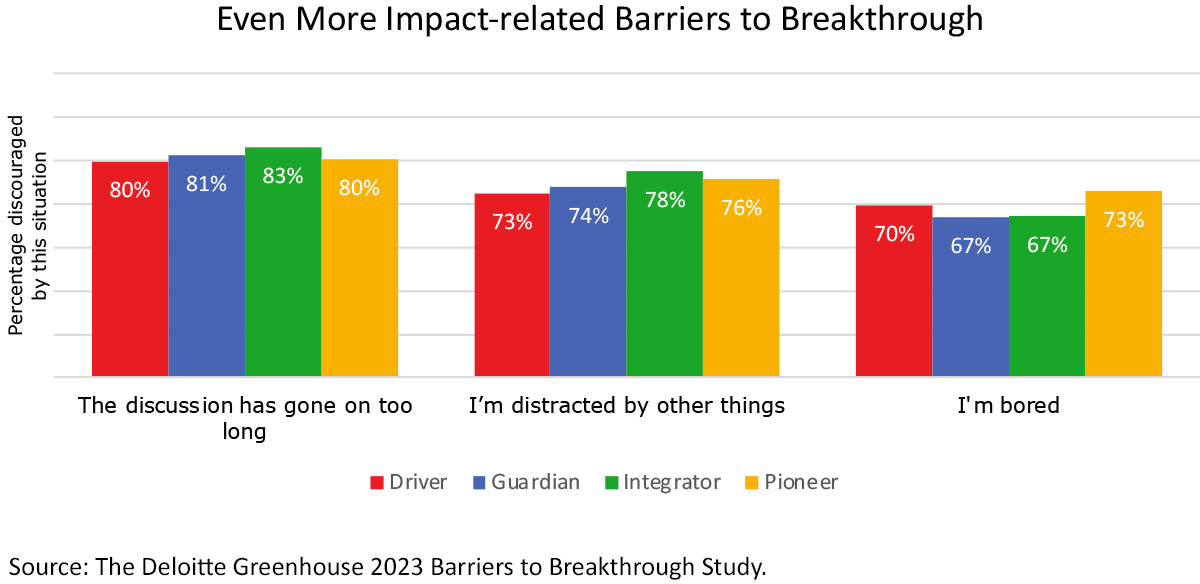What Difference Will it Make? What Teams Lose When People Question the Impact of a Discussion | Deloitte US has been saved
Do you ever sit in a meeting and think, “Who really cares about this, anyway?” Have you ever considered that someone else might be thinking that very same thing in a discussion that you’re leading?
My last post focused on how people’s perceptions about the value of their own opinions, ideas, or questions can keep them from contributing during group discussions. That post was a follow-up to the previous one, which shared the results from our Deloitte Greenhouse 2023 Barriers to Breakthrough study1 exploring the many different reasons people might hesitate to contribute. Here, I’ll explore a second category of potential deterrents identified by that study—those related to impact. These issues revolve around the perceived importance of the topic being discussed and a sense that the discussion matters. Our research found that people may stay quiet if they:
- Aren’t interested in the issue being discussed. (82% might be discouraged from contributing)
- Don’t think the issue being discussed is important. (74%)
- Feel their time or energy would be better spent elsewhere. (76%)
- Don’t think the discussion will make a difference. (76%)
- Think it seems like a decision has already been made. (71%)
- Don’t think the right people are in the room for the discussion. (71%)
- Don’t think their contribution will make a difference. (64%)
- Feel the discussion has gone on too long. (81%)
- Are distracted by other things. (75%)
- Are bored. (69%)
Sometimes people just don’t think a topic is particularly important, interesting, or worthy of being a priority for them personally. If you don’t have a lot of extra time in your schedule, or extra energy for that matter, spending that time and energy on any one thing leaves less to spend on anything else. People are likely to fully engage in a discussion when they believe it’s not only important or interesting, but even more important or interesting than a lot of other things they could be doing. Since these are potential deterrents for so many people, it seems unwise to assume that your team will think something is important just because you do; it’s possible you’ll have to convince them. And although the differences aren’t large, we can see here that Pioneers and Drivers are even more likely to be deterred by these issues than Guardians and Integrators. So they, in particular, might need convincing.

To remedy this challenge you might proactively show team members why the topic or problem matters and could be a good use of their time and energy. And I use the word show rather than tell deliberately. One way to show rather than tell is to immerse people in the problem, placing them right into the scene, which can activate them not only intellectually, but emotionally and physically. This method builds on a concept in psychology called embodied cognition, which posits that the body, and the body’s movements and experiences, can influence the mind. Getting people moving can result in significantly deeper engagement, greater trust and openness, and increased diversity of ideas.
For example, if your team is struggling to prioritize time and resources, you could try telling them how important it is, or you could fill a room with objects representing the various demands that need to be prioritized. For example, maybe the team could label varying sized blocks with each priority—larger blocks for those that take more time and resources. Then ask them to fill a bag that’s too small to fit all the blocks. Team members can then discuss the pros and cons of including each priority as they place them in the bag or put them back down. Suddenly the challenge has become more real, and people have shifted from being passive spectators to active participants. Any invitation to make a mess—or to start interacting, building, and creating, rather than just talking—is likely to have a similar effect.
Even if people feel a topic or problem is worth their time and energy, they may think the discussion itself is not going to make a difference, so why bother? You’ve likely been part of discussions that never carried through to make any kind of real impact. These experiences can be exacerbated by well-meaning managers who, in the spirit of being inclusive, invite lots of people to share their thoughts but never loop back to inform people of how their input influenced the outcome or, alternatively, why it didn’t. Again these issues can be discouraging for lots of people, so don't count on team members assuming a particular discussion will matter. Instead, once more, you may need to convince them.

You can start by communicating the plan for how the discussion and any resulting ideas will be used and who will ultimately make decisions. If participants might feel a decision has already been made, explain how you anticipate any new information will be integrated. This might be particularly important for your Guardians and Integrators, who are more likely to be discouraged by the perception that the decision is already a done deal. If participants—especially your Drivers and Pioneers—could think the right people aren’t in the room, communicate how you expect the outcomes from the discussion will reach the right people. If perhaps participants might wonder whether their individual contributions will matter, be sure to tell them why their input is valued. Again, this might be most important for your Guardians and Integrators, who are most likely to be inhibited by questioning the value of their own contributions. These methods will likely be easier if you have a proven track record of following through. If not, you can start establishing that reputation now. Consistency will be key to building and maintaining it.

Think back to when you were last part of a discussion that just seemed to drag on and on. Was it easy to stay engaged? How about when you felt hungry, uncomfortable, distracted, or bored? It’s important to remember that the people we’re counting on to contribute great ideas are just that: people. If you fail to take into account their humanness, you’re unlikely to get the best from them. When you're looking to get people’s best, don’t leave it to chance; design the experience to help them focus on the work you want them to do. You certainly don’t want to let those Pioneers get bored! I’ve written before about the many ways in which you can design meetings and discussions to accommodate people’s humanity and their different preferences. Check out those posts here and here.
Beyond the action of immersion that I’ve already touched on, aiming to bring people to a state of immersion is another approach to engaging them. Neuroscientist Paul J. Zak studies experiences that lead to action (or don’t). According to his work, immersion is the neurologic state that transports people to new worlds, absorbs them in an experience, and motivates action. In his book, Immersion: The Science of the Extraordinary and the Source of Happiness, he says to achieve the state of immersion, “first get my attention, then give me a reason to care about what I’m experiencing.” In the Deloitte Greenhouse, we often use surprise and delight to get people’s attention. Unexpected situations spark your brain, heightening senses and emotions, and amplifying creativity, memory, and ability to learn. To give people a reason to care, we dial up the drama, leaning into story-telling and other techniques to tap into people’s emotions. Zak says that “emotional experiences are tagged by the brain as important.” And that’s one of the reasons stories and emotionally compelling experiences can be powerfully engaging.
Here’s a technique for immersing people in a problem that we share in our upcoming book, The Breakthrough Manifesto: 10 Principles to Spark Transformative Innovation.
Immerse Yourselves
Step 1: Determine what context best makes sense for your problem or initial idea. Are you in a hospital? A home? Another planet?
Step 2: Provide your group with materials to construct their environment(s). Include blank-canvas kinds of materials like posters, whiteboards, etc. as well as evocative props like furniture, paintings, stuffed animals, fake campfires … whatever might be helpful in setting the scene. Don’t worry about being too precise—part of what makes the process messy is having things that don’t quite fit that people find a way to work in.
Step 3: Use the materials to create a physical landscape, ideally one that surrounds you and the team so you feel like you are within that environment versus on the side observing it. Encourage everyone to contribute to the building effort in parallel. Resist the temptation to assign an architect or chief builder. Remember, a bit of chaos here is good.
Step 4: Once your environment(s) are complete, spend time within the environment discussing your idea. (For example, talk about how customers might order a product inside a fully automated store while inside the mockup you’ve built of that store.) Play out different scenarios within the space.
Step 5: Keep iterating on your environment as needed to reflect the discussions!

For more on helping your teams get creative together, pre-order our new book: The Breakthrough Manifesto: 10 Principles to Spark Transformative Innovation (by Kim Christfort & Suzanne Vickberg, Wiley, 2023)
And still relevant as ever, you can also order: Business Chemistry: Practical Magic for Crafting Powerful Work Relationships (by Kim Christfort & Suzanne Vickberg, Wiley, 2018)
1 Between September 2019 and March 2020, and then again between September 2020 and July 2021, all respondents who completed the online Business Chemistry assessment were asked about the conditions that would discourage them from contributing in a group setting. More than 28,000 professionals from hundreds of organizations responded.
Get in touch

Suzanne Vickberg (aka Dr. Suz)
Dr. Suz is a social-personality psychologist and a leading practitioner of Deloitte’s Business Chemistry, which Deloitte uses to guide clients as they explore how their work is shaped by the mix of individuals who make up a team. Previously serving in Deloitte’s Talent organization, since 2014 she’s been coaching leaders and teams in creating cultures that enable each member to thrive and make their best contribution. Along with her Deloitte Greenhouse colleague Kim Christfort, Suzanne co-authored the book Business Chemistry: Practical Magic for Crafting Powerful Work Relationships as well as a Harvard Business Review cover feature on the same topic. She also leads the Deloitte Greenhouse research program focused on Business Chemistry and is the primary author of the Business Chemistry blog. An “unapologetic introvert” and Business Chemistry Guardian-Dreamer, you will never-the-less often find her in front of a room, a camera, or a podcast microphone speaking about Business Chemistry or Suzanne and Kim’s second book, The Breakthrough Manifesto: Ten Principles to Spark Transformative Innovation, which digs deep into methodologies and mindsets to help obliterate barriers to change and ignite a whole new level of creative problem-solving. Suzanne is a University of Wisconsin-Madison graduate with an MBA from New York University’s Stern School of Business and a doctorate in Social-Personality Psychology from the Graduate Center at the City University of New York. She is also a professional coach, certified by the International Coaching Federation. She has lectured at Rutgers Business School and several colleges in the CUNY system, and before joining Deloitte in 2009, she gained experience in the health care and consulting fields. A mom of two teenagers, she maintains her native Minnesota roots and currently resides in New Jersey, where she volunteers for several local organizations with a focus on hunger relief.
